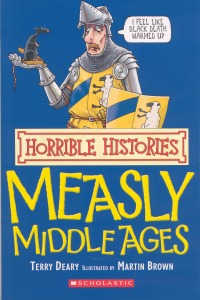| ________________
CM . . .
. Volume XIV Number 9 . . . .December 21, 2007
excerpt:
Deary and Brown's series, "Horrible Histories," was first published in the UK in the 1990s. The volumes present a compendium of curious historical facts packaged in a humorous, if rather oddball fashion, imbued with a very British sense of wit with ample plays-on-words, references to school dinners, and in Measly Middle Ages, liberal use of the pejorative adjective measly. Brown's entertaining illustrations appear on almost every page and often take the form of a cartoon cell, or a sample text, such as a recipe or list of rules presented in a calligraphic style. Measly Middle Ages focuses upon historical events and everyday life in Great Britain in the period 1066-1492, with some examples from France, Italy and other parts of Europe. Information is grouped into 11 chapters with headings such as Nasty Normans, Foul food, Woeful women, and Rotten religion. The simple text incorporates lists, quizzes, excerpts from poems or other printed works, and imagined letters.
Recommended with reservations. Val Ken Lem is a catalogue librarian and the liaison for History, English and Caribbean Studies at Ryerson University in Toronto, ON.
To comment
on this title or this review, send mail to cm@umanitoba.ca.
Copyright © the Manitoba Library Association. Reproduction for personal
use is permitted only if this copyright notice is maintained. Any
other reproduction is prohibited without permission.
NEXT REVIEW |
TABLE OF CONTENTS FOR THIS ISSUE
- December 21, 2007.
AUTHORS |
TITLES |
MEDIA REVIEWS |
PROFILES |
BACK ISSUES |
SEARCH |
CMARCHIVE |
HOME |
